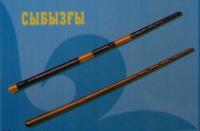Вы здесь
Sybyzgy.

Kazakhstan Live.
The sybyzgy is the instrument most frequently mentioned in ethnographic literature of 18th-19th centuries. However, since the end of XIXth century it is rarely met. It is easily made by perforating three or four finger holes in a cane 500 - 700 mm long.
Since the XIXth century sybyzgy is also made of metal. It is a favourite instrument of herdsmen and mostly used for playing songs and kyuis of lyrical character, which helped to preserve the most ancient mi: cal art.
Amongst the wind instruments sybyzgy was the most favourite instrument. It entered the musical life of the people. Sybyzgy helped the shepherds in solitude at the far-away grasslands. It brought joy to people during the evening hours of rest when the musicians were telling and playing beautiful ancient legends and stories. Sybyzgy-players were always welcome to all toys and feasts.
Wide popularity of sybyzgy was connected with the simplicity it was made. Sybyzgy was made of hollow reed tube, on which three holes were cut. It was easy and fast to make sybyzgy, but it was very difficult to play it. Sybyzgy kuis were usually two-voice melodies: the first voice was extracted from the instrument and the second voice represented the guttural sound of the musician-performer.
It was necessary to master the technique of simultaneous performance of both voices. Besides reed sybyzgy there were also wooden sybyzgy.
The playing technique is complex due to its primitive nature. However, it is this design that gives the quivering, 'natural' timbre and rich overtone sounds that makes playing the ancient bourdon duo phony possible.
Blowing the three-holed instrument produces a scale of over two octaves. It is used in modern bands and orchestras.
Authority:
http://www.bukhara-carpets.com
Photo
Alexander Petrov.







